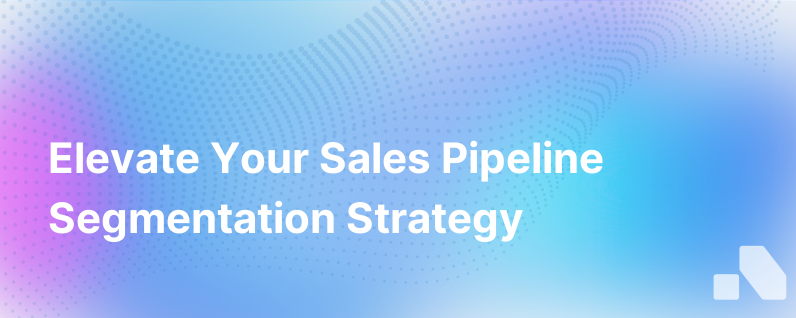
In the intricate dance of B2B sales and marketing, the quality of your pipeline can dramatically impact everything from forecasting accuracy to revenue outcomes. And while a robust sales pipeline is a universal aim, not all pipelines are created equal. Enter pipeline segmentation: the fine-tuning operation that takes your generic, one-size-fits-all pipeline and tailors it for efficiency, insight, and laser-focused strategy execution.
Why Pipeline Segmentation Matters
To understand why segmentation is pivotal, consider a pipeline as a river, where water flow symbolizes potential revenue streams. Without direction, the water's power is diffused. But guided through carefully constructed channels, its force is magnified, powering the turbines of your business engine with unmatched precision and strength.
Here’s why segmentation can raise the bar:
-
Enhances focus and prioritization: It allows your sales teams to allocate their time and resources more effectively by targeting the segments that have the highest potential for conversion and profit.
-
Improves forecasting accuracy: Segmentation helps in identifying patterns and trends within different segments, which results in more accurate sales forecasting.
-
Facilitates personalized marketing strategies: Marketing efforts can be tailored to address the specific needs and behaviors of each segment.
-
Enables performance measurement and improvement: By breaking down the pipeline into discrete segments, it’s easier to measure and optimize the performance of individual areas.
The Principles of Effective Pipeline Segmentation
Successful pipeline segmentation is both an art and a science. It requires thoughtful consideration of various factors to devise logical, insightful segments that drive action and results. Here are foundational principles to adhere to:
- Relevancy: Segmentation criteria should reflect your business objectives and sales strategies. Irrelevant segmentation leads to wasted effort.
- Measurable: Each segment should have clear, quantifiable characteristics to make performance tracking feasible.
- Accessible: The segments should be reachable and actionable by your sales and marketing teams.
- Substantial: The size of each segment must justify the resource allocation.
- Actionable: The segmentation should inform and drive specific sales strategies and tactics.
Crafting Your Pipeline Segmentation Strategy
Here we'll outline a strategic blueprint to reimagine your pipeline segmentation process.
Identifying Key Segmentation Variables
Firstly, determine the variables that matter most to your business. These might include industry verticals, company size, geographic location, customer maturity, purchasing authority, or product interest. These factors capture the essence of potential clients, highlighting areas where unique needs or opportunities exist.
Analyzing Historical Data and Trends
Your CRM and sales data are mines of insight. By analyzing past wins (and losses), you can uncover patterns that inform your segmentation. Perhaps certain industries yield higher conversion rates, or specific regions have untapped potential. This approach can uncover latent market segments ripe for the taking.
Aligning Sales and Marketing
Alignment between sales and marketing is crucial for segmentation to succeed. The two departments should agree on the definitions and expectations for each segment, ensuring that messaging and outreach efforts are synchronized.
Prioritize and Focus
Once segmentation is complete, it's time to prioritize. Not all segments hold equal value. Prioritization might be based on potential deal size, strategic importance, or as Aomni suggests, real-time data and insights.
Customizing Strategies for Each Segment
Strategies that whisper directly to the unique needs and pain points of each segment will always resonate more powerfully than generic outreach. For instance, an industry that values innovation might respond to forward-thinking messaging, while cost-sensitive segments might require a benefits-oriented approach.
Integrating Technology and Tools
Segmentation isn't static; it's a dynamic process that requires continuous refinement. Leveraging tools like Aomni can automate data aggregation and real-time insights, transforming how segments are identified, understood, and engaged.
Advanced Techniques in Pipeline Segmentation
Moving beyond the basics, sophisticated segmentation addresses not just who the customers are but also their behavioral and psychographic attributes.
Account-Based Marketing (ABM)
ABM embellishes pipeline segmentation with a hyper-personalized approach, often focusing on individual accounts with tailored marketing strategies. Each key account becomes its own segment, demanding a unique strategy.
Predictive Analytics
Predictive analytics use historical data, algorithms, and machine learning to anticipate future behaviors. By predicting which segments are more likely to convert or expand, you can direct resources more effectively.
The Lifecycle Stage Approach
Understanding where a prospect is in the buyer’s journey allows for tailored communication, whether they are at the awareness, consideration, or decision stage.
Psychographic Segmentation
Beyond demographics, psychographics delve into the attitudes, aspirations, and other psychological criteria that influence buying decisions. This approach can refine how you connect with each segment at a deeper level.
Measuring Success and Iterating
Segmentation isn’t set-it-and-forget-it; it's imperative to track metrics and KPIs to gauge the success of your segmentation efforts. These metrics might include segment growth, conversion rates, average deal size, customer lifetime value (CLV), and more. The insights gathered will help you iterate and refine your segmentation strategy continually.
Conclusion
Elevating your pipeline through thoughtful segmentation is a journey of strategic discovery. The added granularity it offers can turn a blur of prospects into a focused target list, and scattergun marketing into a sniper’s approach. Essentially, well-segmented pipelines enable a degree of personalization and efficiency that, in today's competitive landscape, isn’t just nice to have—it’s critical.
A strategic tool like Aomni can greatly enhance this process by leveraging the power of AI to offer real-time insights, making pipeline segmentation not just smarter, but also more responsive to the rapidly changing business environment. By harnessing application intelligence, pipeline segmentation evolves from a static marketing tactic to a dynamic growth engine, driving your B2B sales mission forward with unprecedented clarity and focus.